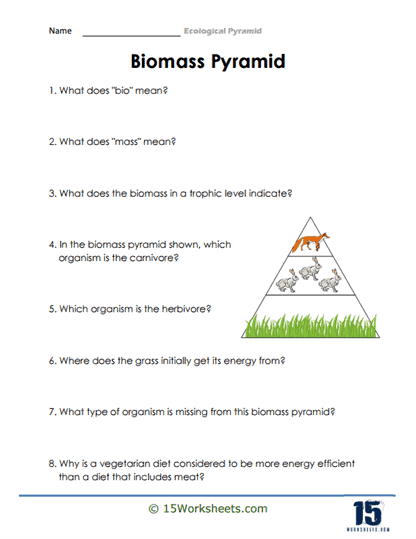Biomass Within Ecosystems

Worksheet Description
This worksheet helps students better understand this concept through the use of a live walk through.
The worksheet looks at biomass within ecosystems, focusing on its distribution across different trophic levels. Through a series of questions, students are prompted to explore the meanings of the terms “bio” and “mass”, comprehend what biomass indicates at each trophic level, and identify specific organisms within the pyramid based on their roles as herbivores or carnivores. The worksheet also prompts learners to ponder the source of energy for primary producers and explore the broader implications of dietary choices in the context of energy efficiency. The visual representation of the pyramid, coupled with these questions, offers a comprehensive exploration of the topic.
To adeptly navigate this worksheet, students should begin by familiarizing themselves with the basic definitions of “bio” and “mass”. Armed with this foundational knowledge, they can then understand “biomass” as the total mass of living organisms in a given area or ecosystem. Next, by examining the visual pyramid, students should discern the roles of different organisms and how biomass typically decreases as one moves up the trophic levels. They should also reflect on the origins of energy at the base level and be prepared to discuss the energy implications of different diets, understanding the fundamental differences in energy transfer between trophic levels.
The core objective of this worksheet is to instill in students an understanding of the biomass distribution within an ecosystem. It aims to highlight the decreasing nature of biomass as one ascends the trophic levels, emphasizing that while primary producers like grass have a high biomass, apex predators have significantly less due to energy and biomass losses at each successive level. The worksheet also seeks to spark curiosity about the origins of energy in ecosystems and the energy implications of our dietary choices. Through this, students not only grasp the concept of biomass but also appreciate the intricate balance and relationships that govern ecosystems.
Biomass refers to any organic matter that comes from plants or animals, which can be used as a source of energy. Biomass can include everything from wood and agricultural waste to animal manure and sewage sludge.
